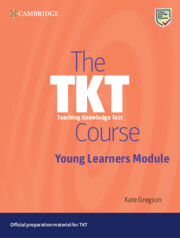Book contents
- Frontmatter
- Acknowledgements
- Contents
- Introduction
- Part 1 Knowledge of young learners and principles of teaching English to young learners
- Part 2 Planning and preparing young learner lessons
- Part 3 Teaching young learners
- Part 4 Assessing young learner learning in the classroom
- Follow-up activities: Answer keys and commentaries
- List of terms found in the TKT Glossary
- Glossary of TKT: Young Learners terms
- Test tips for TKT: Young Learners
- Teaching knowledge test young learners: Practice test
- Sample test answer sheet for TKT: YL practice test
- Answer key for TKT: YL practice test
Unit 4 - Developing communication skills: How can I help children develop communication strategies through language learning?
Published online by Cambridge University Press: 14 March 2024
- Frontmatter
- Acknowledgements
- Contents
- Introduction
- Part 1 Knowledge of young learners and principles of teaching English to young learners
- Part 2 Planning and preparing young learner lessons
- Part 3 Teaching young learners
- Part 4 Assessing young learner learning in the classroom
- Follow-up activities: Answer keys and commentaries
- List of terms found in the TKT Glossary
- Glossary of TKT: Young Learners terms
- Test tips for TKT: Young Learners
- Teaching knowledge test young learners: Practice test
- Sample test answer sheet for TKT: YL practice test
- Answer key for TKT: YL practice test
Summary
LEARNING OUTCOMES
By the end of this unit, you will…
KNOWLEDGE: know more about language and non-language strategies commonly used in communication
SKILLS: be able to identify a range of communication strategies and ways of helping children to develop them through language learning
■ Starter Question
Before you begin this unit, read the starter question and make some notes. Then read the commentary and compare it to your notes.
What do people use in order to communicate? List as many points as you can.
COMMENTARY
When people interact with one another, they communicate using words and other non-language tools. We begin communicating the moment we are born – babies communicate their basic human needs to their parent or carer: I’m hungry! Something hurts! I want a hug! They do this by crying and cooing. As we grow up, we begin to convey information more precisely – older babies will begin to use simple words, like More!, gestures such as reaching, and later, pointing. These usually become more intentional strategies before a child's first birthday. Later, our communication becomes more sophisticated, and we can express our needs more precisely and clearly. We become more skilled at communicating using both words and non-language tools, such as gestures, voice, facial expression. For example, to communicate a need for help, we may use the word Help!, but are likely to shout it in a tone of voice which reflects the degree of urgency. We might wave an arm and wear an expression of fear or shock, all depending on the situation.
A function is the reason or purpose for using language, e.g. making a suggestion; giving advice (TKT Glossary, p. 18) and, therefore, functional language is the particular words, chunks or phrases that we use to perform different actions. This language can be categorised in different ways, for example:
1 Personal expression (e.g. talking about yourself, introducing yourself, expressing feelings and emotions)
2 Social interaction (e.g. greeting and introducing people, thanking people, saying goodbye)
3 Conversation skills (e.g. asking for clarification, asking someone to speak more slowly or to explain more clearly)
- Type
- Chapter
- Information
- The TKT Course Young Learners Module , pp. 32 - 40Publisher: Cambridge University PressPrint publication year: 2024

